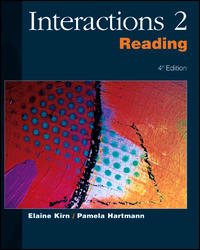 |  Interactions 2 Reading, 4/e Elaine Kirn
Pamela Hartmann
Justice and Racism| Juror: We, the jury, in the above-entitled cause, find the defendant guilty.Judge: It'll be the order of the court that he be committed to the department of corrections for a term of fifteen years...Announcement: Justice is supposed to be blind, including color blind, but is it?Attorney: Because racism still exists in our society, we see it in our court system.Woman: I would say that it's pretty bad. And I would say, from a defendant's point of view, I think it's real bad.Announcer: Racial bias has been and is part of society.Danielson: I mean, what does that say about us? Until we make a better human being, we're going to have to deal with the issue.Announcer: Most of the legal experts we talked to agree that if racism does exist in the courtroom, more often than not, it's centered right here--in the jury box. Jurors may say they say they're impartial, but sometimes they make comments to other jurors about the defendant. Comments like...Attorney:Those people...they don't mind being in jail, or even if we make a mistake on this verdict, people from that community...they don't mind doing time.Man: I don't believe anybody would take the oath, sit on a jury, and say, “My goal here is to try to convict an innocent person of a crime because of that person's race. I have not seen that.Announcer: Superior Court Judge David Danielson finds it hard to believe judges would show racial bias. He says all judges are trained to recognize bias and eliminate it.Danielson: Each judge knows that he or she has an ethical obligation to deal with it, when it occurs in the courtroom. Announcer: Although the court system is getting more diverse, it is still not unusual for a defendant of color to walk into a courtroom and see nothing but white faces.Attorney: You do have the client say to you, “You know, how can I get a fair trial when I'm looking around and everyone else is white?”Announcer: Defense attorneys say that can affect a defendant's attitude, body language, and even testimony.Man: I'm not sure that we can ever create a criminal justice system where someone can walk in and see people of their own race and say, “I am highly comfortable here because of race.” The fact that someone would evaluate their comfort level on the basis of race shows how far we have to go.Announcer: The problem is acknowledged. The solutions...Danielson: It's knowledge, awareness, and education. Before you can solve a problem, it has to be in your mind. You have to get it to your mind by being prepared to look for it.Woman: Racism is going to be marching with us right on into the millennium, even in our criminal justice system, but we'll be able to work with it and deal with it, and one day we will overcome. |
|



 2003 McGraw-Hill Higher Education
2003 McGraw-Hill Higher Education

 2003 McGraw-Hill Higher Education
2003 McGraw-Hill Higher Education